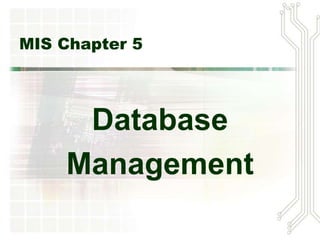
MIS Chapter 5 Database Management Types
- 1. MIS Chapter 5 Database Management
- 2. Types of Malware • Viruses – Self-replicating – E-mail propagation • Trojans – Piggyback on a program – Often pretend to be Antivirus Programs • Worms – Attack networks • Spyware – Keyloggers, browsing history.
- 3. Malware Protection • Keep your software up-to-date. • Verify the source. • Don’t be click – happy. • Use your gut sense. • Install ONE good antivirus.
- 4. Databases • A structured collection of integrated records • Hierarchy of data elements – Data are grouped into columns/fields – Columns grouped into rows/records – Rows are grouped into tables/files • Collection of tables plus relationships among rows
- 6. Relationships • Values in one table may relate to rows/records in other tables • Keys – Column(s) that identify unique row in table – Each table has a key • Foreign keys – Keys of a different table than the one in which they reside • Relational databases – Databases using tables, keys, and foreign keys
- 7. Database vs. DBMS • A Database is a structured collection of records or data that is stored in a computer system so that a computer program or person using a query language can consult it to answer queries. • The computer program used to manage and query a database is known as a database management system (DBMS).
- 9. Types of DBMS • Personal DBMS products – Microsoft Access – Everything in one package • Enterprise DBMS products – IBM: DB2 – Microsoft: SQL Server – Oracle – MySQL (open source)
- 10. Database Systems • DBMS used to create tables, relationships in databases. • Applications use DBMS to read, insert, modify, and delete data – Structured Query Language (SQL
- 12. Database Applications • Forms – Used to read, insert, modify, and delete data • Reports – Show data in structured context – May compute values • Queries – Are a means of getting answers from database data
